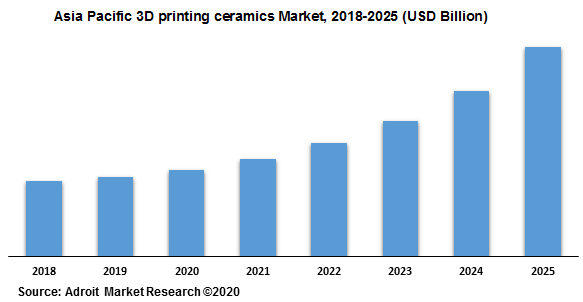Global 3D printing ceramics market accounted for a market revenue of nearly 37 million in the year 2019 and is projected to grow at a CAGR of more than 28% over the forecast period. Today, ceramic 3D printers are mostly expensive industrial additive manufacturing systems. Photo polymerization. 3D printing, however, is just part of a longer manufacturing cycle. Ceramic 3D printers generate green parts, meaning that they must go through heavy post-processing steps in order to reach their final form. Some of those phases is, for example, firing in a high-temperature furnace the ceramic component or prototype.
Across a variety of sectors, ceramic material is commonly used. Of course, some of the first applications that come to mind are pottery or kitchenware.
The global 3D Printing Ceramics market is expected to develop USD 188.7 Million by 2028, at a compound annual increase in price (CAGR) of 32.6% throughout the forecast period.
.jpg)
But, ceramics are literally everywhere and in many different forms. 3D ceramic material is used in many 3D printing technologies such as powder sintering, paste extrusion, binder jetting, and photo polymerization initiator. Many commercial 3D-ceramic printers use powder sintering or binder jetting. As previously mentioned, green parts are made by ceramic 3D printers. Such green areas must take different steps to arrive at their final form.
3D Printing Ceramics Market Scope
| Metrics | Details |
| Base Year | 2023 |
| Historic Data | 2018-2022 |
| Forecast Period | 2024-2028 |
| Study Period | 2018-2028 |
| Forecast Unit | Value (USD) |
| Revenue forecast in 2028 | USD 188.7 Million |
| Growth Rate | CAGR of 32.6% during 2018-2028 |
| Segment Covered | by Beer Type, by Price Category, by Distribution Channel, Regions |
| Regions Covered | North America, Europe, Asia Pacific, South America, Middle East and Africa |
| Key Players Profiled | 3D Ceram, Lithoz GmbH, Exone GmbH, EOS GmbH Electro Optical Systems, CRP Group, 3D Systems Corporation, Materialise NV, Renishaw PLC, Tethon 3D, and Stratasys, Ltd. |
Key Segment Of The 3D Printing Ceramics Market
By Type (USD Million)
• Glass
• Quartz
• Fused Silica
• Others
By Form (USD Million)
• Liquid
• Filament
• Powder
By End-User (USD Million)
• Aerospace & Defense
• Healthcare
• Automotive
• Others
Regional Overview (USD Million)
North America
• US
• Canada
Europe
• Germany
• France
• UK
• Rest of Europe
Asia Pacific
• China
• India
• Japan
• Rest of Asia Pacific
South America
• Mexico
• Brazil
• Rest of South America
Middle East and South Africa
Frequently Asked Questions (FAQ) :
The emergence of three-dimensional (3D) printing technologies, also referred to as additive manufacturing (AM), is regarded as a manufacturing revolution. 3D printing is the innovative manufacturing technique that allows the modular development, using traditional methods such as machining and casting, of highly complex and precise structures that are hard to implement. As many objects can be generated in a single run, efficiency can also be greatly increased. After its inception, 3D printing has quickly progressed into the realm of science and technology
In terms of type the global 3D printing ceramics market is segmented into Glass, Fused Silica, Quartz, Others. In terms of form, the market is divided into Filament, Liquid, Powder. Similarly, in terms of application, the market is segmented into Aerospace & Defense, Healthcare, Automotive, Consumer Goods & Electronics, Manufacturing & Construction, Other.

In the world of design, manufacturing, and architecture, 3D Printing is the latest technology growth surge. There are also incentives for business vendors for versatility to develop and produce operations. 3D printing is expected to be a major priority of the ceramic industry and helps face these challenges.
In terms of geography, the global 3D printing ceramic is segmented into North America, Europe, Asia Pacific, Central & South America, and Middle East & Africa. North America is projected to lead the global market owing to advancement in the technology and presence of key industrial players.
Key players operating in this market comprises of 3D Systems Corporation, Stratasys, Ltd., EOS GmbH Electro Optical Systems, CRP Group, Materialise NV, Exone GmbH, Renishaw PLC, Tethon 3D, 3D Ceram, Lithoz GmbH, Viridis 3D LLC.

